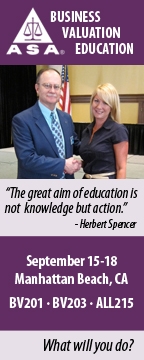
| September 14, 2011 | Issue #108-1 |
Does the BV profession suffer from ‘interservice rivalry’? Business valuation is a relatively small profession—yet it supports not one, not two, but FIVE different credentials, notes Raymond J. ("RJ") Dragon (Rotenberg Meril Solomon) in his recent blog post, “Rating the Business Valuation Credentials.” “This BV equivalent of 'interservice rivalry' has had good and bad effects,” Dragon says:
By analogy, he says, what if the auditing profession came with an Accredited Senior Auditor (ASA), an Accredited Public Accountant (APA), and even a Chartered Business Accountant (CBA), each with different levels of training and experience, and all boasting that their credential demonstrates superior knowledge of the profession? To confirm what really makes a good BV expert, “a two-year valuation experience minimum should be required to earn a credential,” Dragon believes, adding that the ASA “is on the right track to require significant valuation training.” Let us know your opinion. FASB adds new initiative on impairment of intangibles After the FASB received feedback on its proposed standards for testing goodwill impairment project, it added a new project on the impairment of intangible assets with indefinite lives, reports Michael Conn in Accounting Today. “The new project’s scope is to simplify the manner in which an entity tests other indefinite-lived intangible assets for impairment,” Conn reports. The FASB has not yet indicated when it will complete the new initiative or how it will fit into the ongoing goodwill impairment project. How will FASB’s new intangibles initiative impact BV analysts? According to Brad Pursel (Brown Smith Wallace LLC):
FCC licenses have private economic value, including goodwill Long-established federal law prohibits the owners of FCC licenses from pledging the licenses themselves as collateral. Aware of these regulations, a mobile satellite provider granted its secured note holders an interest in all economic proceeds from the “sale, transfer, or other disposition” of their FCC licenses as well as any related “goodwill or other intangible rights.” After the company went bankrupt, the Sprint Nextel Corporation sued the debtors for the $104 million that it cost them to clear the satellite bandwidth that the debtors once owned. To satisfy its admittedly unsecured claim, Sprint sought to void or at least gain seniority over the secured note holders’ interest by filing various motions in the bankruptcy proceeding, essentially arguing that the note holders’ lien in the economic value of the licenses was invalid under the same law that precludes granting a collateral interest in FCC licenses themselves. An opportunity for bankruptcy valuation analysts? Despite some prior conflict among federal court and administrative rulings concerning an owner’s private interest in an FCC license versus the FCC’s public right to regulate its transfer, in this case, the court concluded that the note holders had a valid secured interest in the “economic value” associated with the debtors’ license, “even if they cannot hold a lien on the FCC license itself.” Read the entire digest of In re Terrestar Networks, Inc., 2011 WL 3654543 (Bkrtcy. S.D.N.Y.)(Aug. 19, 2011) in the October 2011 Business Valuation Library; the court’s complete opinion will be posted soon at BVLaw. AICPA announces Fall 2011 ABV and CFF credential exams According to BVR’s 2011/2012 BV Firm Economics and Best Practices Guide, the ABV credential ranked second (only behind the CPA) as the most common certification in the business valuation profession. Due to the continued rapid growth in the BV and forensic accounting specialty niches, the AICPA’s Forensic and Valuation Services Section encourages CPAs to earn the Accredited in Business Valuation (ABV) and Certified in Financial Forensics (CFF) Credentials. To prepare for the ABV Exam:
To prepare for the CFF Exam: Distinguish your CPA practice with the powerful combination of an ABV or CFF Credential. Registration closes Nov. 1: this will be your last chance to sit for the ABV Exam or the CFF Exam in 2011. Is the IRS ‘overcritical’ of data sources in its DLOM Aid? Attorney and BV insider Paul Hood provides an executive summary of the IRS Discount for Lack of Marketability Job Aid on his recent blog, The Business Valuation Reviewer’s Handbook. “On the whole, the Job Aid is fairly well done,” Hood says, although it is not without its problems. For instance, “the Job Aid left out several other DLOM methods of which I am aware,” Hood notes. “Additionally, the Job Aid severely and somewhat uncharacteristically (for the Job Aid) criticizes the FMV Opinions restricted stock model, which strongly suggests that the IRS must be seeing a lot of this in use.” Have you downloaded the Job Aid yet? If not, you can still join the nearly 590 analysts, attorneys, and other visitors who downloaded the Discount for Lack of Marketability Job Aid for IRS Valuation Professionals at BVResources during the month of August. Or try the next most popular (and *free*) downloads: “Goodwill Hunting in Divorce,” a state-by-state summary on the distinction that courts make between enterprise and professional goodwill in divorce (recently updated to include the latest decision); and “Examples of Factors Implementing Personal Goodwill in Cases,” a checklist by James Alerding (Clifton Gunderson) and Andrew Soshnick, Esq. M&A market is rebounding, thanks to financial and IT spending M&A activity in the U.S. increased 8% in the first half of 2011 compared with the same period in 2010, reports Ari Goldschneider (Grant Thornton) in Dealmaker (Summer 2011). Activity from financial buyers accounts for 40% of overall growth in M&A activity. “Finding a willing financial buyer is becoming more feasible as funds keep chipping away at their large quantities of uninvested capital and the debt market for sponsor-based deals remains stable,” says Goldschneider. According to the Q2 2011 Software Equity Industry Report, “public software, Internet and software as a service (SaaS) market valuations benefited from the rebound in IT spending, record levels in Internet retail sales, and sharply higher online advertising spending.” Valuing a software company? BVR has just added “Software Firms: Update on Industry Information” as a free download here. Damodaran invites you to the ‘dark side’ of Aswath Damodaran, Professor of Finance at the NYU Stern School of Business, is teaching one class this year—valuation—and you are invited to attend. In a recent blog post, the Professor explains how you can sign up, access lecture notes, watch webcasts, get emails, and even take quizzes and exams. An excerpt from his summary:
Access HL’s ‘Risky Risk Rate’ article online The article mentioned in last week’s BVWire—currently titled, “The ‘Risky’ Risk-Free Rate: Does the Downgrade of U.S. Sovereign Debt Change Commonly-Used Valuation Approaches?” by Houlihan Lokey professionals is now posted on the HL website. A first for BV in Africa NACVA, under the auspices of its international arm, the International Association of Consultants, Valuators and Analysts (IACVA), will be administering a CVA test in Accra, Ghana in November, creating possibly the first instance of BV testing on that continent. Ghana is a natural location because it adoption IFRS early and many of its accountants have actively reached out for international business valuation training. Bennet Kpentey (Sync Consult Ltd.) is the current president of the Ghana Charter of IACVA. The examination follows the teaching last month of NACVA’s intangible asset valuation class by Jim Catty (Corporate Valuation Services Ltd.). Catty, the chair of IACVA, reports that 50 financial professionals attended his session. Pepperdine private capital markets project requests your input John Paglia (Pepperdine University) is conducting a research survey on “privately held companies and the markets in which they raise capital.” Your individual responses will be kept confidential, and by participating in the survey you will receive a complimentary report on business financing and private capital markets in advance of general distribution. Complete the survey here by Friday, September 16th. Filling fall with CPE opportunities
Copyright © 2011 by Business Valuation Resources, LLC |
|




